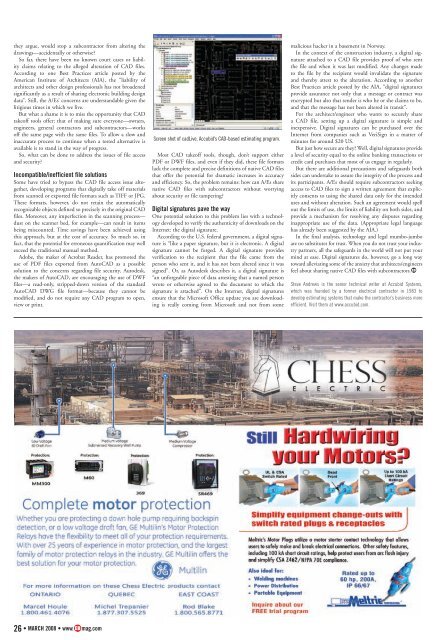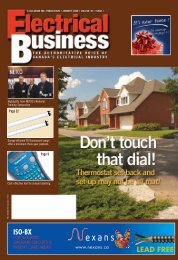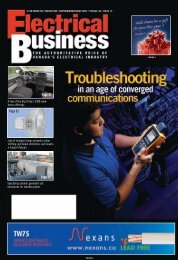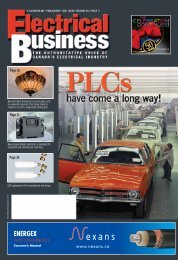Page 11 Page 34 Page 22 - Electrical Business Magazine
Page 11 Page 34 Page 22 - Electrical Business Magazine
Page 11 Page 34 Page 22 - Electrical Business Magazine
- No tags were found...
You also want an ePaper? Increase the reach of your titles
YUMPU automatically turns print PDFs into web optimized ePapers that Google loves.
they argue, would stop a subcontractor from altering thedrawings—accidentally or otherwise?So far, there have been no known court cases or liabilityclaims relating to the alleged alteration of CAD files.According to one Best Practices article posted by theAmerican Institute of Architects (AIA), the “liability ofarchitects and other design professionals has not broadenedsignificantly as a result of sharing electronic building designdata”. Still, the A/Es’ concerns are understandable given thelitigious times in which we live.But what a shame it is to miss the opportunity that CADtakeoff tools offer; that of making sure everyone—owners,engineers, general contractors and subcontractors—worksoff the same page with the same files. To allow a slow andinaccurate process to continue when a tested alternative isavailable is to stand in the way of progress.So, what can be done to address the issues of file accessand security?Incompatible/inefficient file solutionsSome have tried to bypass the CAD file access issue altogether,developing programs that digitally take off materialsfrom scanned or exported file formats such as TIFF or JPG.These formats, however, do not retain the automaticallyrecognizable objects defined so precisely in the original CADfiles. Moreover, any imperfection in the scanning process—dust on the scanner bed, for example—can result in itemsbeing miscounted. Time savings have been achieved usingthis approach, but at the cost of accuracy. So much so, infact, that the potential for erroneous quantification may wellexceed the traditional manual method.Adobe, the maker of Acrobat Reader, has promoted theuse of PDF files exported from AutoCAD as a possiblesolution to the concerns regarding file security. Autodesk,the makers of AutoCAD, are encouraging the use of DWFfiles—a read-only, stripped-down version of the standardAutoCAD DWG file format—because they cannot bemodified, and do not require any CAD program to open,view or print.Screen shot of cadLive, Accubid’s CAD-based estimating program.Most CAD takeoff tools, though, don’t support eitherPDF or DWF files, and even if they did, these file formatslack the complete and precise definitions of native CAD filesthat offer the potential for dramatic increases in accuracyand efficiency. So, the problem remains: how can A/Es sharenative CAD files with subcontractors without worryingabout security or file tampering?Digital signatures pave the wayOne potential solution to this problem lies with a technologydeveloped to verify the authenticity of downloads on theInternet: the digital signature.According to the U.S. federal government, a digital signatureis “like a paper signature, but it is electronic. A digitalsignature cannot be forged. A digital signature providesverification to the recipient that the file came from theperson who sent it, and it has not been altered since it wassigned”. Or, as Autodesk describes it, a digital signature is“an unforgeable piece of data attesting that a named personwrote or otherwise agreed to the document to which thesignature is attached”. On the Internet, digital signaturesensure that the Microsoft Office update you are downloadingis really coming from Microsoft and not from somemalicious hacker in a basement in Norway.In the context of the construction industry, a digital signatureattached to a CAD file provides proof of who sentthe file and when it was last modified. Any changes madeto the file by the recipient would invalidate the signatureand thereby attest to the alteration. According to anotherBest Practices article posted by the AIA, “digital signaturesprovide assurance not only that a message or contract wasencrypted but also that sender is who he or she claims to be,and that the message has not been altered in transit”.For the architect/engineer who wants to securely sharea CAD file, setting up a digital signature is simple andinexpensive. Digital signatures can be purchased over theInternet from companies such as VeriSign in a matter ofminutes for around $20 US.But just how secure are they? Well, digital signatures providea level of security equal to the online banking transactions orcredit card purchases that most of us engage in regularly.But there are additional precautions and safeguards bothsides can undertake to assure the integrity of the process andits participants. A/Es should require subcontractors seekingaccess to CAD files to sign a written agreement that explicitlyconsents to using the shared data only for the intendeduses and without alteration. Such an agreement would spellout the limits of use, the limits of liability on both sides, andprovide a mechanism for resolving any disputes regardinginappropriate use of the data. (Appropriate legal languagehas already been suggested by the AIA.)In the final analysis, technology and legal mumbo-jumboare no substitutes for trust. When you do not trust your industrypartners, all the safeguards in the world will not put yourmind at ease. Digital signatures do, however, go a long waytoward alleviating some of the anxiety that architects/engineersfeel about sharing native CAD files with subcontractors.Steve Andrews is the senior technical writer at Accubid Systems,which was founded by a former electrical contractor in 1983 todevelop estimating systems that make the contractor’s business moreefficient. Visit them at www.accubid.com.Chess_EB_March08.indd 126 • MARCH 2008 • www. mag.com2/14/08 3:36:37 PM
















